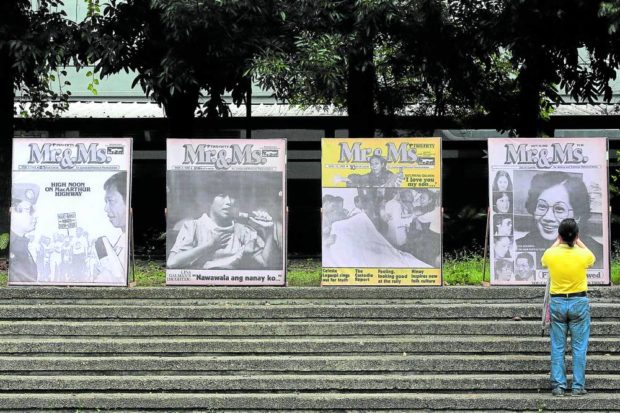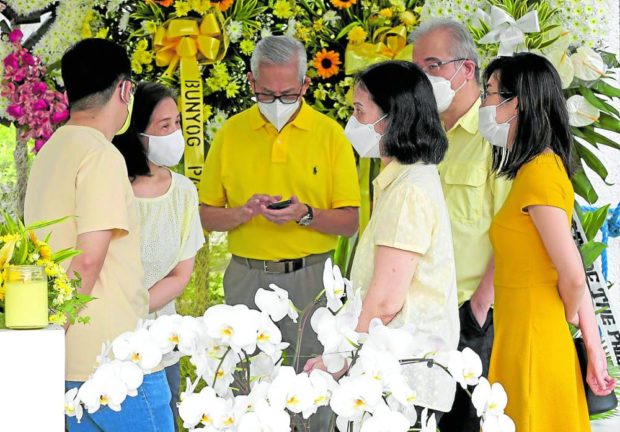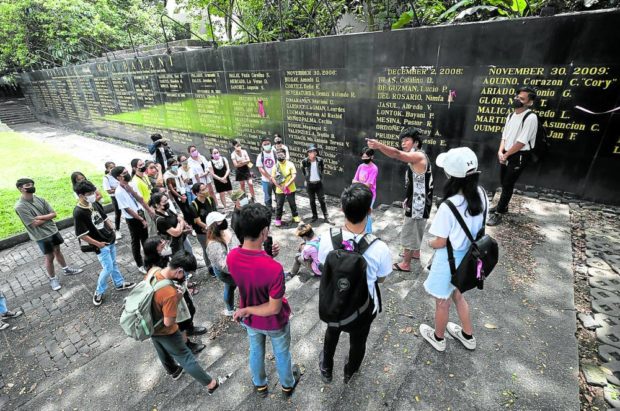Rights activists vow to protect Ninoy’s place in history

FOR POSTERITY | A visitor takes photos of blown-up images of Mr. & Ms. magazine covers at Bantayog ng mga Bayani in Quezon City on Saturday. The political edition of the women’s magazine, published by Eugenia Apostol and edited by Letty Jimenez-Magsanoc, was a popular reading fare in the twilight of the Marcos dictatorship. (Photo by GRIG C. MONTEGRANDE / Philippine Daily Inquirer)
MANILA, Philippines — Amid efforts to undermine and distort former Sen. Benigno “Ninoy” Aquino Jr.’s life and legacy, Church leaders and martial law survivors vowed to protect his place in Philippine history and warned that there would be a “day of reckoning” against the forces who lie and distort the truth.
On Aquino’s 39th death anniversary — the first to be commemorated under a Marcos presidency — his supporters vowed to keep his legacy burning even with the constant threat of disinformation and historical distortion.
On Aug. 21, 1983, Aquino, the most prominent critic of the father and namesake of President Ferdinand Marcos Jr., was shot dead moments after he stepped out of the plane, accompanied by government escorts, upon his arrival after three years of exile in the United States.
While Filipinos used to revere him as a martyr and icon of Philippine democracy, fake news and conspiracy theories about his death have greatly distorted his legacy as social media trolls painted him a false hero.
“Ninoy Aquino was not a saint,” Archbishop Socrates Villegas said during his commemorative Mass at the Metropolitan Cathedral of Dagupan. “But there was something great in him and that is why we pray for his soul.”
Article continues after this advertisement“Maybe he is not the pious prayer leader we have. But there must be something great in him because how can God not be in a man who willingly laid his life so that freedom may be won and truth may prevail?” he added.
Article continues after this advertisement“His memory lives on because that is the reward of being honest, of being truthful, of being selfless, and of standing up for freedom. You live forever, you are remembered forever and you are set as an example for others to follow,” he said.
For martial law victims
In Concepcion town in Tarlac province, a grandson of the late senator said the day should also be dedicated to the memory of the thousands who died during martial law.
“It is sad that the memory of these victims is being disregarded now. The dictatorship had thousands of victims we should fight for. So we believe that Aug. 21 is also for them, especially now that the 50th anniversary of martial law is coming on Sept. 21,” said Francis Joseph Aquino Dee, a son of Viel Aquino-Dee, one of the daughters of Ninoy Aquino and the late former president Corazon Aquino.
Simple ceremonies to commemorate Aquino’s death anniversary were held on Sunday morning in front of his monument at the municipal quadrangle of Concepcion, his hometown, where Aquino served as mayor before he became governor of the province.
Residents and other supporters of the Aquino family here released yellow balloons and filled his monument with wreaths of flowers.
“Holidays are made so we can remember. When disinformation happens and people want us to forget, the more we need to commemorate,” historian Xiao Chua said in an interview on Saturday.

ANOTHER YEAR | Viel Aquino-Dee (second from left) and Ballsy Aquino-Cruz (third from right) visit the tomb of their father, the late Sen. Benigno “Ninoy” Aquino Jr. whose 39th death anniversary was observed on Sunday at Manila Memorial Park in Parañaque City. (Photo by RICHARD A. REYES / Philippine Daily Inquirer)
“We don’t need to introduce Ninoy here in Concepcion but outside our town, many people might not know the story of his life. It is worse now that there are movements which aim to change history and erase his heroic acts,” former Sen. Bam Aquino said in a message delivered by his brother, Paul Victor Aquino. Bam failed to attend the event on Sunday after he tested positive for COVID-19, according to his brother.
At the height of the campaign for the May elections, Ninoy’s statue in Tarlac City’s Plazuela was covered by a tent and a tarpaulin during the grand rally on April 3 of the UniTeam tandem of then candidates Ferdinand Marcos Jr. and Sara Duterte.
Palace quiet
Breaking tradition, Malacañang did not issue a statement marking Ninoy Aquino Day.
Former President Rodrigo Duterte issued statements for the holiday from 2018 to 2021, based on a search of the Office of the Press Secretary website.
On Facebook, the National Commission for Culture and the Arts, Philippine Postal Corp., the Quezon City government, the Tarlac provincial government, and several public elementary and high schools and state colleges were among the government entities that posted about Ninoy Aquino Day on Sunday.
The National Wages and Productivity Commission also posted about the holiday but only to remind workers about the general “no work, no pay” policy applicable for the day.
The holiday was created through Republic Act No. 9256 in February 2004. The law stated that the Edsa People Power Commission, created in 1999, shall plan and implement appropriate ceremonies for the observance of Ninoy Aquino Day.
In November 2017, Rodrigo Duterte issued an executive order integrating the functions of the commission with the National Historical Commission of the Philippines.
Still relevant
At Bantayog ng mga Bayani, martial law survivors called on Filipinos to resurrect not the specter of “Apo Lakay”—the moniker for Marcos Sr. by his supporters—but Aquino’s spirit instead.
“People ask us if we’re still relevant in this time because we’re all super-seniors already,” said former activist Edith Reyes, member of the August Twenty-One Movement (Atom) formed by Aquino’s brother Butz. “But I firmly believe that we will always be relevant as long as there are people who seek out the truth.”
Chilling footage of Aquino’s final moments as he stepped out of the plane opened the program. Rebecca Quijano, the lone eyewitness to Aquino’s assassination, was brought to tears at the memory.

NEVER FORGET | Addressing youths visiting the Bantayog ng mga Bayani for the first time on Sunday, activist Jay-R Reyes talks about the many Filipinos who sacrificed their lives in the struggle against martial rule, including the late former Sen. Benigno “Ninoy” Aquino Jr. whose death anniversary was commemorated on Sunday. (Photo by LYN RILLON / Philippine Daily Inquirer)
But even more so, she was “extremely worried that what I had personally seen that day would just be distorted by fake news,” she told the Inquirer.
Quijano, called in news accounts as the “crying lady,” was on the same China Airlines Flight 811 that brought Aquino back to the country. She testified to seeing one of Aquino’s military escorts shoot the senator at the back of his head.
She said she hoped that one day, Filipinos would “start believing again in the people who were there and who know what happened.”
Young students like Dandred Eriga, 21, echoed her sentiment. “I am here because I want to stand for what is right, especially right now na grabe ang historical revisionism sa bansa.”
TIMELINE
1967 – Tarlac Gov. Benigno “Ninoy” Aquino Jr. is elected senator, the country’s youngest, at 35 years old. President Ferdinand Marcos Sr. campaigns against his senatorial bid, but Aquino places second, the only winning Liberal Party candidate in a race swept by the ruling Nacionalista Party.
1969 – Marcos wins a second term amid accusations of vote-buying and intimidation. But this new term beginning in January 1970 would be rocked by such episodes as the First Quarter Storm protest movement that year and the Plaza Miranda bombing of Aug. 21, 1971.
Sept. 13, 1972 – In a privilege speech, Aquino exposes Oplan Sagittarius, allegedly a master plan by Marcos to perpetuate himself in power, as his second and last term under the 1935 Constitution was due to end in 1973. Under the alleged plot, Greater Manila and the towns of Rizal and the entire Bulacan province would be placed under military control as “prelude, maybe” to the declaration of martial law.
Sept. 22, 1972 – midnight–Aquino, now widely recognized as Marcos’ main political rival, is arrested at the Hilton Hotel in Manila, while in a meeting of the joint congressional committee on tariff reforms, together with Senators Lorenzo Teves (committee chair), Arturo Tolentino, Jose Roy and John Osmeña. A military team led by Col. Romeo Gatan arrives and prevails on Aquino to be placed under arrest.
Aquino is first detained at Fort Bonifacio (the Army headquarters in Metro Manila), together with 10 other critics of Marcos, including Senators Jose Diokno and Ramon Mitra Jr., then briefly at Fort Magsaysay in Laur, Nueva Ecija, where he was placed in solitary confinement. In all, he would spend seven years and seven months in prison.
Sept. 23, 1972 –Marcos declares martial law on national television that Saturday evening, following the mass arrests and raid on media offices which began on Friday night, Sept. 22. His Proclamation No. 1081 is backdated to Sept. 21, making the date divisible by 7, which he regards as a lucky number in keeping with his fascination for numerology.
April 4, 1975 – Aquino begins a 40-day hunger strike to protest his trial for subversion and other crimes.
Nov. 25, 1977 – He is convicted of all charges and sentenced to death. But Marcos commutes the sentence and Aquino would remain in jail for three more years until he suffers from two heart attacks in early 1980.
1980 – Aquino is allowed to undergo heart surgery in the United States, where he would spend three years in self-exile.
Aug. 21, 1983 – Returning from the United States, he is shot dead moments after disembarking from a China Airlines plane, under military escort, at the tarmac of what was then the Manila International Airport. Also killed is Rolando Galman, who the military claims is a communist assassin.
Aug. 31, 1983 – Aquino’s body is entombed at Manila Memorial Park in Parañaque after an 11-hour funeral procession joined by an estimated two million people.